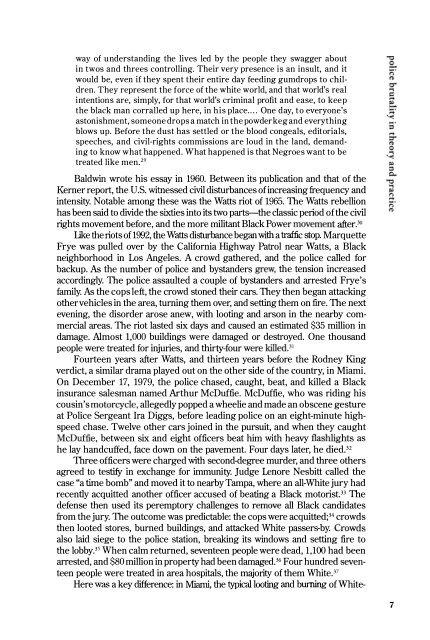Kristian Williams - Our Enemies in Blue - Police and Power in America
Kristian Williams - Our Enemies in Blue - Police and Power in America
Kristian Williams - Our Enemies in Blue - Police and Power in America
Create successful ePaper yourself
Turn your PDF publications into a flip-book with our unique Google optimized e-Paper software.
way of underst<strong>and</strong><strong>in</strong>g the lives led by the people they swagger about<strong>in</strong> twos <strong>and</strong> threes controll<strong>in</strong>g. Their very presence is an <strong>in</strong>sult, <strong>and</strong> itwould be, even if they spent their entire day feed<strong>in</strong>g gumdrops to children.They represent the force of the white world, <strong>and</strong> that world's real<strong>in</strong>tentions are, simply, for that world's crim<strong>in</strong>al profit <strong>and</strong> ease, to keepthe black man corralled up here, <strong>in</strong> his place .. .. One day, to everyone'sastonishment, someone drops a match <strong>in</strong> the powder keg <strong>and</strong> everyth<strong>in</strong>gblows up. Before the dust has settled or the blood congeals, editorials,speeches, <strong>and</strong> civil-rights commissions are loud <strong>in</strong> the l<strong>and</strong>, dem<strong>and</strong><strong>in</strong>gto know what happened. What happened is that Negroes want to betreated like men. 29Baldw<strong>in</strong> wrote his essay <strong>in</strong> 1960. Between its publication <strong>and</strong> that of theKerner report, the U.S. witnessed civil disturbances of <strong>in</strong>creas<strong>in</strong>g frequency <strong>and</strong><strong>in</strong>tensity. Notable among these was the Watts riot of 1965. The Watts rebellionhas been said to divide the sixties <strong>in</strong>to its two parts-the classic period of the civilrights movement before, <strong>and</strong> the more militant Black <strong>Power</strong> movement after.30like the riots of 1992, the Watts disturbance began with a traffic stop. MarquetteFrye was pulled over by the California Highway Patrol near Watts, a Blackneighborhood <strong>in</strong> Los Angeles. A crowd gathered, <strong>and</strong> the police called forbackup. As the number of police <strong>and</strong> byst<strong>and</strong>ers grew, the tension <strong>in</strong>creasedaccord<strong>in</strong>gly. The police assaulted a couple of byst<strong>and</strong>ers <strong>and</strong> arrested Frye'sfamily. As the cops left, the crowd stoned their cars. They then began attack<strong>in</strong>gother vehicles <strong>in</strong> the area, turn<strong>in</strong>g them over, <strong>and</strong> sett<strong>in</strong>g them on fire. The nexteven<strong>in</strong>g, the disorder arose anew, with loot<strong>in</strong>g <strong>and</strong> arson <strong>in</strong> the nearby commercialareas. The riot lasted six days <strong>and</strong> caused an estimated $35 million <strong>in</strong>damage. Almost 1,000 build<strong>in</strong>gs were damaged or destroyed. One thous<strong>and</strong>people were treated for <strong>in</strong>juries, <strong>and</strong> thirty -four were killed.3!Fourteen years after Watts, <strong>and</strong> thirteen years before the Rodney K<strong>in</strong>gverdict, a similar drama played out on the other side of the country, <strong>in</strong> Miami.On December 17, 1979, the police chased, caught, beat, <strong>and</strong> killed a Black<strong>in</strong>surance salesman named Arthur McDuffie. McDuffie, who was rid<strong>in</strong>g hiscous<strong>in</strong>'s motorcycle, allegedly popped a wheelie <strong>and</strong> made an obscene gestureat <strong>Police</strong> Sergeant Ira Diggs, before lead<strong>in</strong>g police on an eight-m<strong>in</strong>ute highspeedchase. Twelve other cars jo<strong>in</strong>ed <strong>in</strong> the pursuit, <strong>and</strong> when they caughtMcDuffie, between six <strong>and</strong> eight officers beat him with heavy flashlights ashe lay h<strong>and</strong>cuffed, face down on the pavement. Four days later, he died.32Three officers were charged with second-degree murder, <strong>and</strong> three othersagreed to testify <strong>in</strong> exchange for immunity. Judge Lenore Nesbitt called thecase "a time bomb" <strong>and</strong> moved it to nearby Tampa, where an all-White jury hadrecently acquitted another officer accused of beat<strong>in</strong>g a Black motorist.33 Thedefense then used its peremptory challenges to remove all Black c<strong>and</strong>idatesfrom the jury. The outcome was predictable: the cops were acquitted;34 crowdsthen looted stores, burned build<strong>in</strong>gs, <strong>and</strong> attacked White passers-by. Crowdsalso laid siege to the police station, break<strong>in</strong>g its w<strong>in</strong>dows <strong>and</strong> sett<strong>in</strong>g fire tothe lobby.35 When calm returned, seventeen people were dead, 1,100 had beenarrested, <strong>and</strong> $80 million <strong>in</strong> property had been damaged.36 Four hundred seventeenpeople were treated <strong>in</strong> area hospitals, the majority of them White.rHere was a key difference: <strong>in</strong> Miami, the typical loot<strong>in</strong>g <strong>and</strong> burn<strong>in</strong>g of White-7


